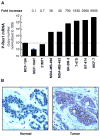Rac signaling in breast cancer: a tale of GEFs and GAPs
- PMID: 21893191
- PMCID: PMC3312797
- DOI: 10.1016/j.cellsig.2011.08.011
Rac signaling in breast cancer: a tale of GEFs and GAPs
Abstract
Rac GTPases, small G-proteins widely implicated in tumorigenesis and metastasis, transduce signals from tyrosine-kinase, G-protein-coupled receptors (GPCRs), and integrins, and control a number of essential cellular functions including motility, adhesion, and proliferation. Deregulation of Rac signaling in cancer is generally a consequence of enhanced upstream inputs from tyrosine-kinase receptors, PI3K or Guanine nucleotide Exchange Factors (GEFs), or reduced Rac inactivation by GTPase Activating Proteins (GAPs). In breast cancer cells Rac1 is a downstream effector of ErbB receptors and mediates migratory responses by ErbB1/EGFR ligands such as EGF or TGFα and ErbB3 ligands such as heregulins. Recent advances in the field led to the identification of the Rac-GEF P-Rex1 as an essential mediator of Rac1 responses in breast cancer cells. P-Rex1 is activated by the PI3K product PIP3 and Gβγ subunits, and integrates signals from ErbB receptors and GPCRs. Most notably, P-Rex1 is highly overexpressed in human luminal breast tumors, particularly those expressing ErbB2 and estrogen receptor (ER). The P-Rex1/Rac signaling pathway may represent an attractive target for breast cancer therapy.
Copyright © 2011. Published by Elsevier Inc.
Figures



Similar articles
-
Identification of the Rac-GEF P-Rex1 as an essential mediator of ErbB signaling in breast cancer.Mol Cell. 2010 Dec 22;40(6):877-92. doi: 10.1016/j.molcel.2010.11.029. Mol Cell. 2010. PMID: 21172654 Free PMC article.
-
P-Rex1 participates in Neuregulin-ErbB signal transduction and its expression correlates with patient outcome in breast cancer.Oncogene. 2011 Mar 3;30(9):1059-71. doi: 10.1038/onc.2010.489. Epub 2010 Nov 1. Oncogene. 2011. PMID: 21042280
-
The P-Rex1/Rac signaling pathway as a point of convergence for HER/ErbB receptor and GPCR responses.Small GTPases. 2018 Jul 4;9(4):297-303. doi: 10.1080/21541248.2016.1221273. Epub 2016 Sep 2. Small GTPases. 2018. PMID: 27588611 Free PMC article. Review.
-
Phosphorylation of P-Rex1 at serine 1169 participates in IGF-1R signaling in breast cancer cells.Cell Signal. 2013 Nov;25(11):2281-9. doi: 10.1016/j.cellsig.2013.07.018. Epub 2013 Jul 27. Cell Signal. 2013. PMID: 23899556
-
The Rho guanine nucleotide exchange factor P-Rex1 as a potential drug target for cancer metastasis and inflammatory diseases.Pharmacol Res. 2020 Mar;153:104676. doi: 10.1016/j.phrs.2020.104676. Epub 2020 Jan 30. Pharmacol Res. 2020. PMID: 32006571 Review.
Cited by
-
Rac inhibition as a novel therapeutic strategy for EGFR/HER2 targeted therapy resistant breast cancer.BMC Cancer. 2021 Jun 1;21(1):652. doi: 10.1186/s12885-021-08366-7. BMC Cancer. 2021. PMID: 34074257 Free PMC article.
-
Genetic disruption of the small GTPase RAC1 prevents plexiform neurofibroma formation in mice with neurofibromatosis type 1.J Biol Chem. 2020 Jul 17;295(29):9948-9958. doi: 10.1074/jbc.RA119.010981. Epub 2020 May 29. J Biol Chem. 2020. PMID: 32471868 Free PMC article.
-
Phosphorylation of α-tubulin by protein kinase C stimulates microtubule dynamics in human breast cells.Cytoskeleton (Hoboken). 2014 Apr;71(4):257-72. doi: 10.1002/cm.21167. Epub 2014 Feb 26. Cytoskeleton (Hoboken). 2014. PMID: 24574051 Free PMC article.
-
Differential roles and activation of mammalian target of rapamycin complexes 1 and 2 during cell migration in prostate cancer cells.Prostate. 2020 Apr;80(5):412-423. doi: 10.1002/pros.23956. Epub 2020 Jan 29. Prostate. 2020. PMID: 31995655 Free PMC article.
-
RAC1 GTP-ase signals Wnt-beta-catenin pathway mediated integrin-directed metastasis-associated tumor cell phenotypes in triple negative breast cancers.Oncotarget. 2017 Jan 10;8(2):3072-3103. doi: 10.18632/oncotarget.13618. Oncotarget. 2017. PMID: 27902969 Free PMC article.
References
-
- Manser E. Dev Cell. 2002;3(3):323–328. - PubMed
-
- Wennerberg K, Der CJ. J Cell Sci. 2004;117(Pt 8):1301–1312. - PubMed
-
- Del Pozo MA, Kiosses WB, Alderson NB, Meller N, Hahn KM, Schwartz MA. Nat Cell Biol. 2002;4(3):232–239. - PubMed
-
- Price LS, Langeslag M, ten Klooster JP, Hordijk PL, Jalink K, Collard JG. J Biol Chem. 2003;278(41):39413–39421. - PubMed
Publication types
MeSH terms
Substances
Grants and funding
LinkOut - more resources
Full Text Sources
Medical
Research Materials
Miscellaneous

